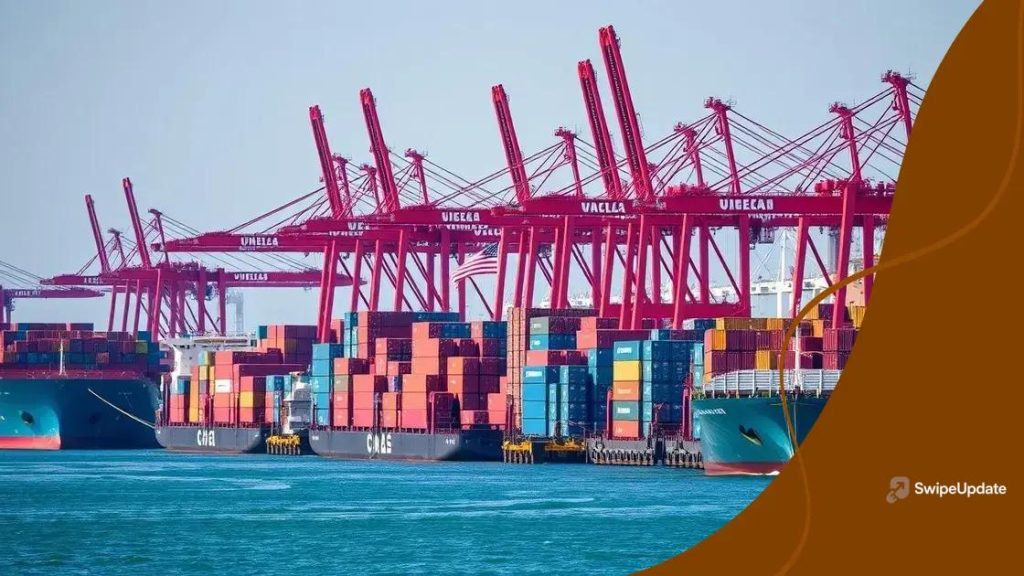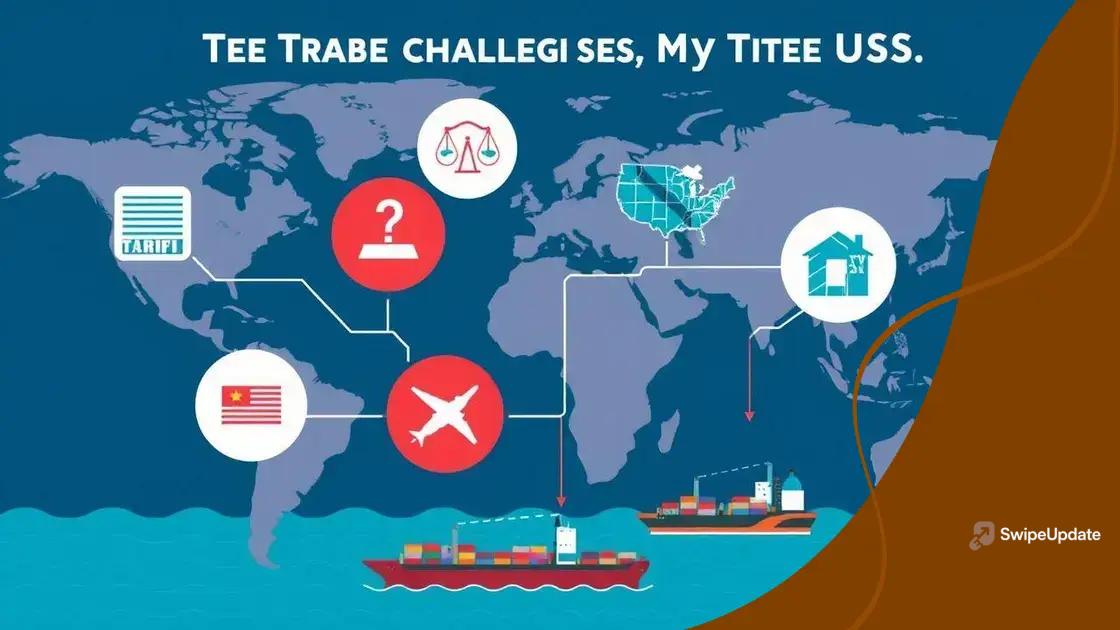The role of the US in global trade dynamics

The role of the US in global trade involves influencing economic policies through trade agreements, managing tariffs, and adapting to emerging challenges while promoting sustainable practices and strengthening international partnerships.
The role of the US in global trade is more significant than many realize. Ever wondered how US policies shape economies around the world? In this post, we’ll dive into the intricacies of this vital topic.
Understanding the US influence on global trade
Understanding the US influence on global trade is key for grasping how economies connect worldwide. The US is a central player in trade, affecting markets and policies across the globe.
This influence has roots in strong economic relationships and robust trade agreements. To illustrate how the US shapes global trade, consider the following:
Key Aspects of US Influence
- Trade Agreements: The US engages in multiple trade agreements that dictate economic interactions.
- Market Trends: US market performance often sets trends that other countries follow.
- Economic Policies: Decisions made in Washington can have worldwide implications.
- Cultural Exchange: Beyond goods, cultural exchanges shape perceptions and relationships.
The relationship between the US and other countries defines trade dynamics. For example, the US has trade partnerships with nations like Canada and Mexico, creating a framework that impacts global supply chains.
Additionally, when the US enacts tariffs, it can ignite changes in trade policies elsewhere. This ripple effect illustrates how deeply intertwined economies have become. US economic stability is often mirrored in countries that depend on its markets.
Challenges to US Influence
Despite its significant role, challenges to US influence in global trade arise. Countries are increasingly exploring bilateral agreements outside traditional frameworks. The emergence of global competitors adds complexity to this landscape. As trade dynamics shift, the US must navigate these challenges carefully to maintain its influential presence.
Understanding the US influence on global trade helps us realize the delicate balance of international relations and economic strategies.
Key trade agreements involving the US
Key trade agreements involving the US have played a vital role in shaping international trade policies. These agreements have established important economic ties not only for the US but also for its trading partners.
One of the most significant agreements is the North American Free Trade Agreement (NAFTA). This agreement was implemented to reduce tariffs and promote trade among the US, Canada, and Mexico. It has transformed how goods move across borders and boosted economic growth in the region.
Notable Trade Agreements
- US-Mexico-Canada Agreement (USMCA): This replaced NAFTA and modernized trade rules, addressing issues like digital trade and labor rights.
- Trans-Pacific Partnership (TPP): Although the US withdrew, this deal aimed to enhance trade with Pacific Rim countries and establish high standards.
- Chile-US Free Trade Agreement: This was the first free trade agreement between the US and a South American country, paving the way for stronger ties.
- US-Korea Free Trade Agreement (KORUS): This agreement has been crucial in strengthening economic relations with South Korea.
Trade agreements generally aim to lower barriers, increase market access, and boost economic cooperation. The impact of these agreements is often seen in job creation and overall economic growth.
In addition to economic benefits, these agreements help foster diplomatic relations. By engaging in trade, countries can build trust and cooperation that extends beyond commerce. For the US, these relationships create a network of allies and contribute to global stability.
Understanding these key trade agreements is essential for grasping the US‘s role in global trade. As the landscape continues to evolve, the importance of adapting to new trade dynamics remains critical.
Challenges faced by the US in trade

The challenges faced by the US in trade are complex and multifaceted. These challenges can significantly impact the country’s position in global markets and its economic strategies.
One major challenge is the increasing competition from emerging markets, such as China and India. These nations are rapidly growing their economies and becoming significant players in international trade. As they innovate and expand their markets, the US must find ways to stay competitive.
Key Issues Affecting US Trade
- Trade Imbalances: The US often runs trade deficits, meaning it imports more than it exports. This situation can lead to economic strain and concern over job losses.
- Tariffs and Trade Wars: Recent tariffs aimed at protecting American industries can lead to retaliation from trading partners, escalating trade tensions.
- Supply Chain Disruptions: Events like the COVID-19 pandemic highlighted vulnerabilities in global supply chains, affecting everything from production to shipping.
- Regulatory Barriers: Strict regulations can complicate trade relationships and hinder US businesses looking to operate abroad.
Additionally, the shifting political landscape can create uncertainty in trade agreements. Changes in administration often lead to a reevaluation of international trade policies, which can disrupt established protocols. The need for stability is crucial for businesses planning long-term investments across borders.
Another challenge is the growing emphasis on sustainability. Many countries are increasingly incorporating environmental standards into trade agreements. The US must adapt to these changes to maintain competitive advantages while meeting global expectations.
Understanding these challenges not only sheds light on the obstacles the US faces but also highlights the strategies needed to navigate the complex world of international trade.
The impact of tariffs on global relationships
The impact of tariffs on global relationships is significant and can reshape the dynamics between countries. Tariffs are taxes imposed on imports, and when one country raises tariffs, it can lead to retaliation from others.
This retaliation can escalate into trade wars, which create tensions and disrupt trade flows. For instance, when the US implemented tariffs on steel and aluminum, countries like Canada and the EU responded with tariffs on American goods, straining diplomatic ties. The situation highlights how tariff policies can translate into broader political conflicts.
Key Effects of Tariffs on Trade Relations
- Increased Prices: Tariffs raise the cost of imported goods, affecting consumers and businesses. Higher prices can lead to reduced sales and economic slowdown.
- Market Access: Countries may find it harder to access each other’s markets, limiting trade opportunities.
- Investment Decisions: Businesses may rethink where to invest based on tariff structures, potentially choosing to relocate to countries with fewer barriers.
- Diplomatic Strain: Disputes over tariffs can lead to a breakdown in negotiations, making future collaborations more challenging.
Moreover, tariffs can lead to a shift in global supply chains. Companies may seek alternatives to avoid high import fees, resulting in new trade partnerships. This shift can benefit some nations while disadvantaging others.
In some cases, tariffs can be used as a point of leverage. Countries can negotiate better trade terms or seek cooperation in other areas. However, this tactic can also backfire, leading to long-term damage in relations that can take years to repair.
Understanding the impact of tariffs is crucial for comprehending how they affect global economic stability and relationships between trading nations.
Future trends in US trade policy
Future trends in US trade policy are poised to reflect the changing dynamics of the global economy. As new challenges arise, the US will need to adapt to maintain its competitive edge.
One emerging trend is the focus on sustainability and environmental standards in trade agreements. Countries are increasingly prioritizing eco-friendly practices, and the US is likely to follow suit to remain an influential trading partner.
Key Trends Shaping US Trade Policy
- Digital Trade Expansion: As technology evolves, digital trade agreements will become vital. The US might work towards rules that support e-commerce and protect intellectual property.
- Strengthening Relationships: The US may seek to strengthen ties with allies, focusing on regional trade partnerships to counterbalance rising powers like China.
- Reshoring Manufacturing: In response to supply chain disruptions, policies encouraging companies to bring manufacturing back to the US are expected to gain traction.
- Trade Policy Flexibility: Future policies may incorporate more flexibility to swiftly respond to global economic changes, allowing for quick adjustments in tariffs or agreements.
The emphasis on fair trade practices is likely to increase. Striking a balance between protecting domestic industries and fostering international cooperation will be key in the coming years. The US will need innovative strategies that ensure equitable benefits for all parties involved.
Moreover, with the ongoing discussions on global inequality, US trade policy may focus more on equitable trade practices that support developing nations, promoting a more balanced global economy.
In summary, adapting to these trends will be crucial for the US to remain a leader in global trade, embracing change while fostering positive relationships with other nations.
FAQ – Frequently Asked Questions about the US Role in Global Trade
What are tariffs and how do they affect international trade?
Tariffs are taxes on imports that can raise prices for consumers and lead to trade tensions between countries.
How do trade agreements shape US trade policy?
Trade agreements establish rules and reduce barriers, promoting smoother trade between the US and its partners.
What is the significance of sustainable practices in trade?
Sustainable practices are increasingly prioritized in trade policies to address environmental concerns and create long-lasting benefits.
How does reshoring manufacturing impact the US economy?
Reshoring manufacturing strengthens the domestic economy by creating jobs and reducing dependency on foreign supply chains.
